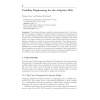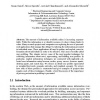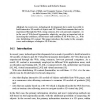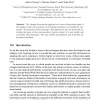ADAPTIVE
2007
Springer
14 years 5 months ago
2007
Springer
ADAPTIVE
2007
Springer
14 years 5 months ago
2007
Springer
Abstract. The amount of information available online is increasing exponentially. While this information is a valuable resource, its sheer volume limits its value. Many research pr...
ADAPTIVE
2007
Springer
14 years 5 months ago
2007
Springer
Ontologies and reasoning are the key terms brought into focus by the semantic web community. Formal representation of ontologies in a common data model on the web can be taken as a...
ADAPTIVE
2007
Springer
14 years 5 months ago
2007
Springer
In recent years, technological developments have made it possible to build interactive 3D models of objects and 3D Virtual Environments that can be experienced through the Web, usi...
ADAPTIVE
2007
Springer
14 years 5 months ago
2007
Springer
This chapter discusses the application of some of the technologies of the adaptive web to the problem of providing information for healthcare consumers. The particular issues relat...
ADAPTIVE
2007
Springer
14 years 5 months ago
2007
Springer
In this chapter we describe techniques for adaptive presentation of content on the Web. We first describe techniques to select and structure the content deemed to be most relevant ...
ADAPTIVE
2007
Springer
14 years 5 months ago
2007
Springer
One distinctive feature of any adaptive system is the user model that represents essential information about each user. This chapter complements other chapters of this book in revi...
ADAPTIVE
2007
Springer
14 years 5 months ago
2007
Springer
Despite the fact that adaptive hypermedia techniques have proven their ability to provide user guidance and orientation in hyperspace, we do not currently see the widespread adopti...
ADAPTIVE
2007
Springer
14 years 5 months ago
2007
Springer
Adaptive navigation support is a specific group of technologies that support user navigation in "virtual spaces" adapting to the goals, preferences and knowledge of the ...
ADAPTIVE
2007
Springer
14 years 5 months ago
2007
Springer
This chapter describes how the adaptive web technologies discussed in this book have been applied to news access. First, we provide an overview of different types of adaptivity in ...





